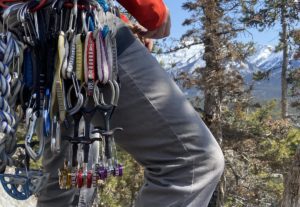Drytooling Tips for Shoulder Season Training
Climbers are trading in the chalk for the tools as fall approaches

Drytooling is a popular shoulder season climbing style in many areas of Canada. You can do it in cool weather, without ice, and it gives you a full body workout that transfers to steep ice and mixed routes. Over the past few years, new crags have been developed, new tools designed, new attitudes adopted. If you visit a drytooling crag this fall, expect to find other climbers running laps on picked-out stone.
Be Strong: Drytooling takes a lot of power, both in your upper and lower body. As top mixed climber Gord McArthur says, “Your core, your upper body, lower back, legs, and shoulders; they all need to be on a solid foundation. Basically, head to toe needs to be firm.” These exercises will give you the foundation moving into sport specific strength training: pull-ups, squats, dead lifts, shoulder press, push-ups, dips and tricep extensions. After you build a solid foundation, then you can shift to more drytool-specific training. Spend a lot of time hanging from the tools, either off a hangboard, tree or beams in the garage. Match your hang time with core fitness, doing mid-body movements you can to build strength.
Tool Angle: In drytooling, the hold is what the pick is resting on, not the handle of your tool. So that means that the pull has to be constant and in line with the rock where your pick sits. You want to be sure that the shaft of your tool is 90 degrees to the horizontal axis of the hold. Holds aren’t always parallel to the ground, so you have to figure out its angle and react. Keep the tool on the hold by positioning your body to keep the pull in a constant direction. If your tool falls out of alignment, then you’ll fall off.
Open Hands: The best drytool climbers almost always have their thumbs open, unless they’re heading through a big roof. As top ice climber Will Gadd states, “With modern leash-less tools, you can almost always relax your hand to a “thumbs open” position after swinging or connecting with a hold (full-weight figure fours are an exception). Really… Most novices and even experienced climbers can hang on a lot longer when I get them to relax their hands and open their thumbs.”
Relax: Drytooling is scary because there’s a lot of potential to get hurt, even when you’re just clipping bolts at a crag. Staying focused and relaxed will help strip the fear away and remove the hesitation from your climbing. As Gadd says, “Trusting your tools involves relaxing, focusing on the required movement, and being O.K. with taking the spinning nasty falls that often result when a tool blows.” If you watch drytoolers at a crag, it’s easy to spot the over gripped ones versus the relaxed ones in the flow.
The Gear: Basically bring everything that you would for a day of cragging in the summer, except pack for colder and wetter conditions. Bring the stick-clip, belay glasses, quickdraws, a durable rope, helmet, tools, crampons, layers, belay puffy, thin gloves and belay gloves and a tarp.
Drytool Technique


